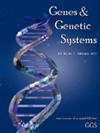n端乙酰转移酶NatB调控酿酒酵母中依赖于rad51的双链断裂修复。
IF 1.2
4区 生物学
Q4 BIOCHEMISTRY & MOLECULAR BIOLOGY
引用次数: 0
摘要
同源重组(Homologous recombination, HR)是一种高度精确的修复DNA双链断裂(DSBs)的机制,这种断裂是由各种基因毒性损伤和阻断复制分叉引起的。HR缺陷和非预定的HR可干扰其他细胞过程,如DNA复制和染色体分离,导致基因组不稳定和细胞死亡。因此,人力资源流程必须严格控制。蛋白质n端乙酰化是真核生物中最常见的修饰之一。在出芽酵母中的研究暗示了NatB乙酰转移酶在HR修复中的作用,但这种修饰如何调节HR修复和基因组完整性尚不清楚。在这项研究中,我们发现缺乏NatB(一种由Nat3和Mdm2组成的二聚体复合物)的细胞对DNA烷基化剂甲基磺酸盐(MMS)敏感,并且Rad51的过表达抑制了nat3Δ细胞对MMS的敏感性。nat3缺陷细胞在释放MMS暴露后,rad52 -黄色荧光蛋白灶水平升高,不能修复dsb。我们还发现Nat3是hr依赖性基因转化和基因靶向所必需的。重要的是,我们观察到nat3Δ突变部分抑制了srs2Δ细胞的MMS敏感性和srs2Δ sgs1Δ细胞的合成疾病。总之,我们的研究结果表明,NatB在Srs2的上游发挥作用,激活依赖rad51的HR通路,以修复DSB。本文章由计算机程序翻译,如有差异,请以英文原文为准。
N-terminal acetyltransferase NatB regulates Rad51-dependent repair of double-strand breaks in Saccharomyces cerevisiae.
Homologous recombination (HR) is a highly accurate mechanism for repairing DNA double-strand breaks (DSBs) that arise from various genotoxic insults and blocked replication forks. Defects in HR and unscheduled HR can interfere with other cellular processes such as DNA replication and chromosome segregation, leading to genome instability and cell death. Therefore, the HR process has to be tightly controlled. Protein N-terminal acetylation is one of the most common modifications in eukaryotic organisms. Studies in budding yeast implicate a role for NatB acetyltransferase in HR repair, but precisely how this modification regulates HR repair and genome integrity is unknown. In this study, we show that cells lacking NatB, a dimeric complex composed of Nat3 and Mdm2, are sensitive to the DNA alkylating agent methyl methanesulfonate (MMS), and that overexpression of Rad51 suppresses the MMS sensitivity of nat3Δ cells. Nat3-deficient cells have increased levels of Rad52-yellow fluorescent protein foci and fail to repair DSBs after release from MMS exposure. We also found that Nat3 is required for HR-dependent gene conversion and gene targeting. Importantly, we observed that nat3Δ mutation partially suppressed MMS sensitivity in srs2Δ cells and the synthetic sickness of srs2Δ sgs1Δ cells. Altogether, our results indicate that NatB functions upstream of Srs2 to activate the Rad51-dependent HR pathway for DSB repair.
求助全文
通过发布文献求助,成功后即可免费获取论文全文。
去求助
来源期刊

Genes & genetic systems
生物-生化与分子生物学
CiteScore
1.50
自引率
0.00%
发文量
22
审稿时长
>12 weeks
期刊介绍:
Genes & Genetic Systems , formerly the Japanese Journal of Genetics ,
is published bimonthly by the Genetics Society of Japan.
 求助内容:
求助内容: 应助结果提醒方式:
应助结果提醒方式:


